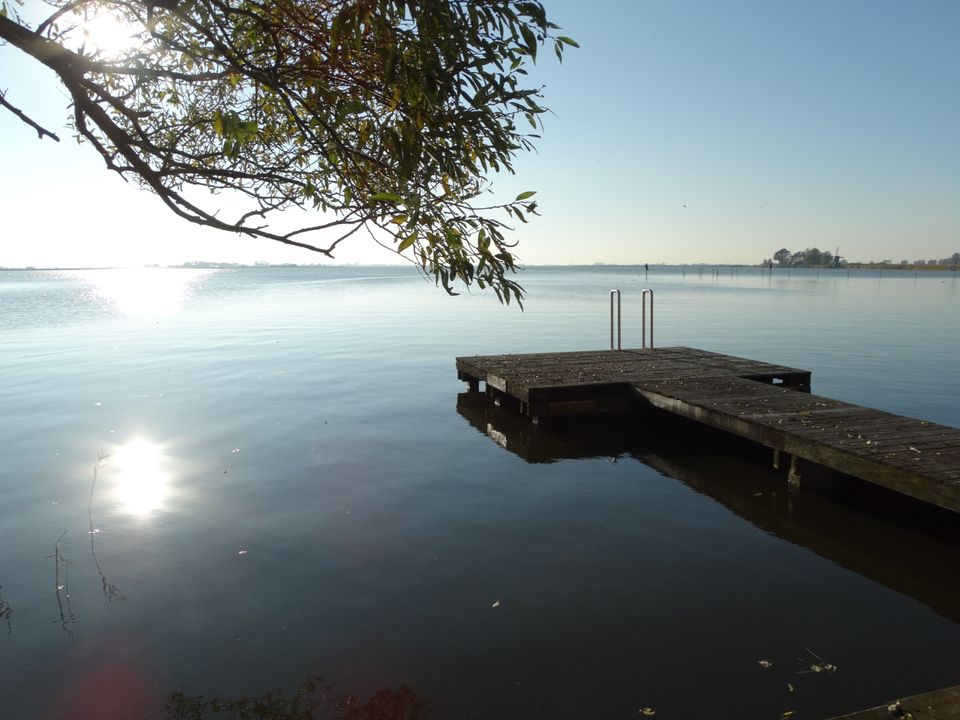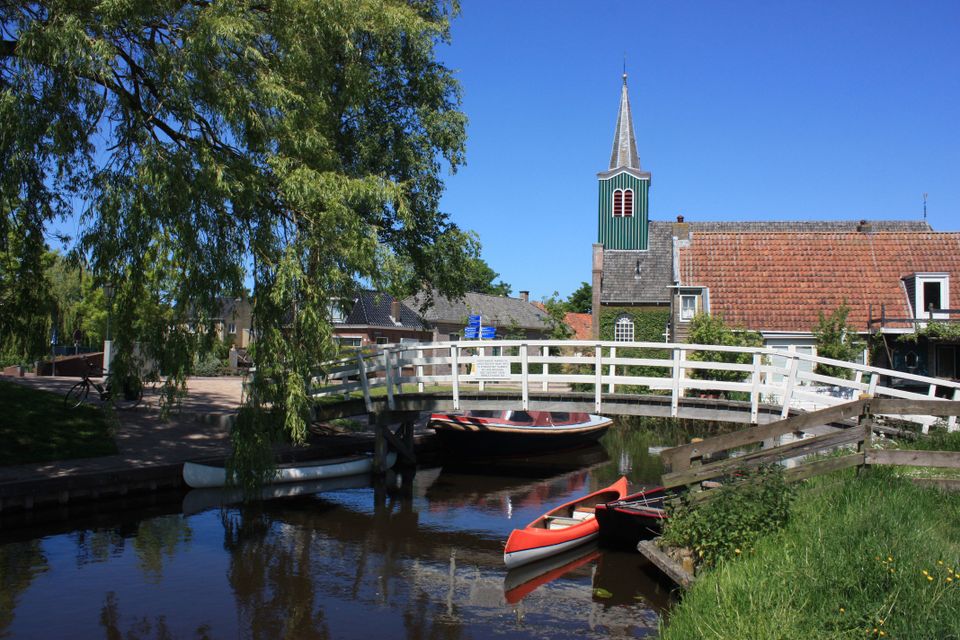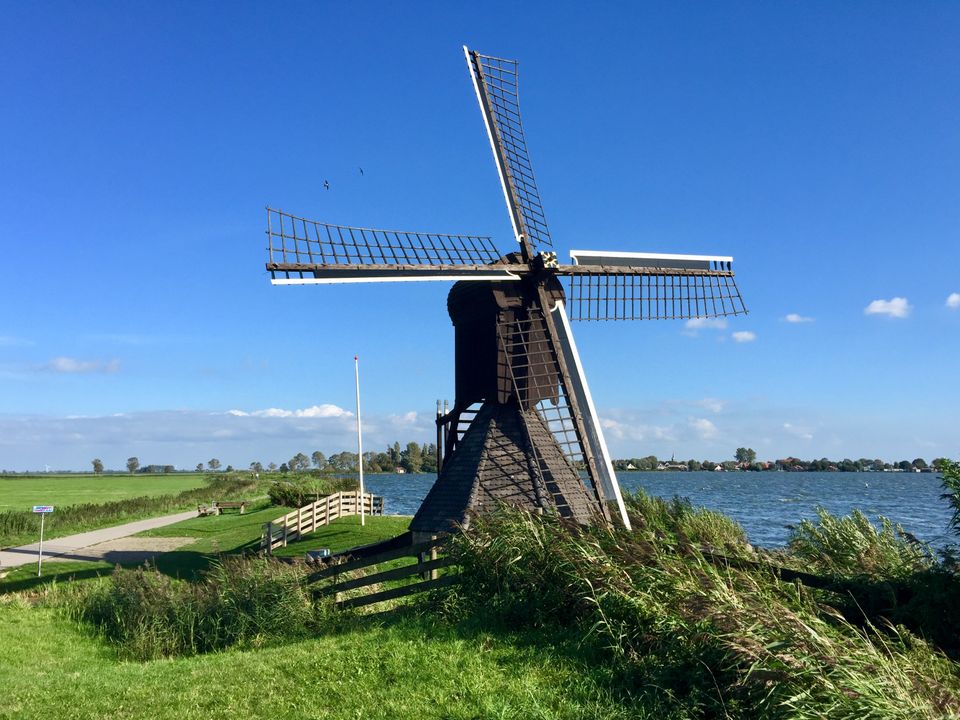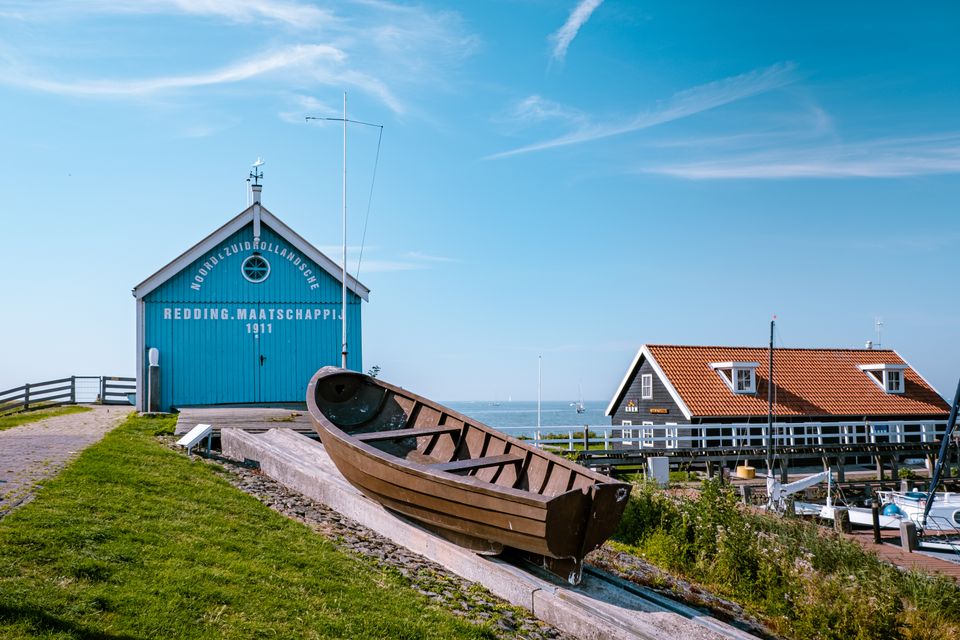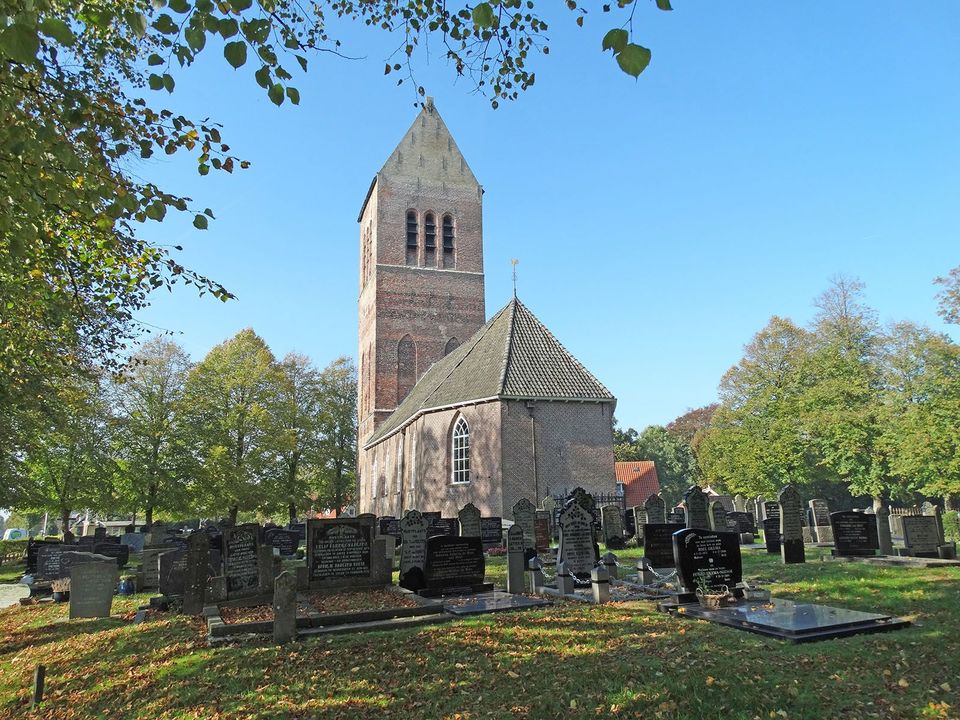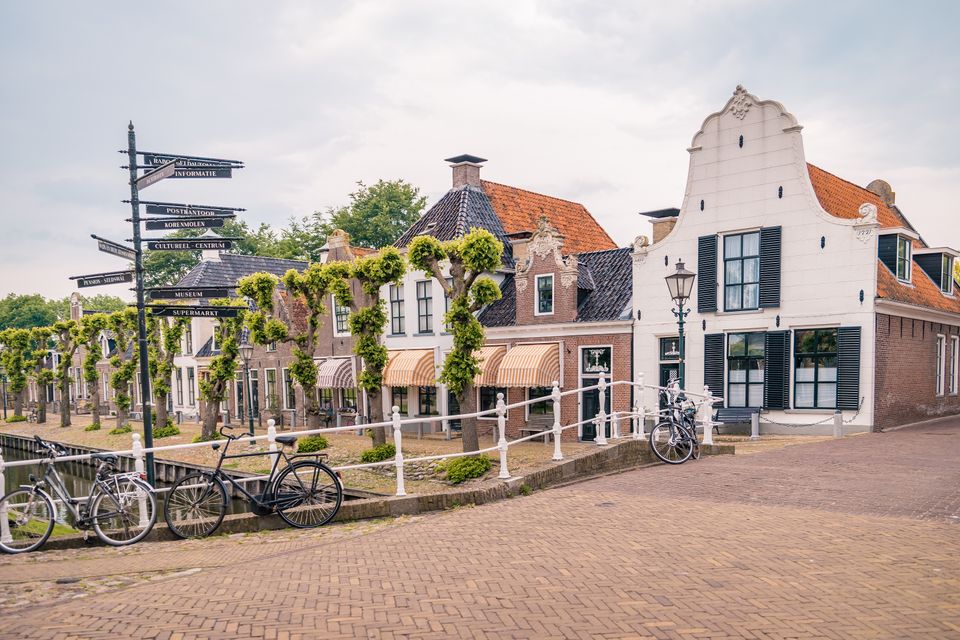Exploring in the footsteps of Odulphus
"Oh how glad I am to live in Oudega, so nice and close to the water," the young woman sighs and hop, there the ball goes into the Aldegeaster Brekken again. Followed in a flying motion by her golden retriever who, as madly as tirelessly, throws herself on the loot. And again. And then again. This is their moment, at the edges of the vast lake that twinkles and shimmers so mysteriously this afternoon. The late sun seems to be carelessly sprinkling frosting.
Land broken by water
No wonder this stretch of the Sint Odulphuspad has been christened Lux Aeterna, or eternal light. The occasional magical light creates a sparkle on the lake that was created about 120,000 years ago, during the penultimate ice age. It is a paradise spot, here at the break. You will find that name more often on the road. In fact, breaches are pools created by dike breaches or peat work and the water sportsman or swimmer is now reaping the benefits of this. Literally it means broken land and that is a lyrical description of the many small and larger lakes that you often see in the Frisian low moor area.
Who was Saint Odulphus?
You can walk in the footsteps of Saint Odulphus on the path of the same name that strings together a large number of pearls of Friesland. The young Odulphus moved from Brabant to Friesland in the 9th century to Christianize the inhabitants. The saint who was called Apostle of the Frisians thus offered guidance, consolation and interpretation of life and left a deep impression on his followers. Many monasteries and courtyards were founded in his name, which had a great influence on the cultivation of the Frisian country. Many of those complexes have disappeared, but the Sint Odulphuspad brings the legacy back to life.
Mosaic of watercourses
If you pick up the map of the province (and that is, see also the tip below, not a superfluous luxury for explorers abroad), a mosaic of waterways forged by Mother Nature and human hands unfolds in Southwest Friesland. Lakes of generous size with side arms in all directions; ditches, pools, wheels and, yes, also breaking. It is that we are now going on foot, but of course you can also take a nice boat trip here. The Aldegeaster Brekken are connected to De Fluessen and the Heegermeer, a few more of those enormous water features. Friesland has a patent on it.
Also striking along the way are the many transformer houses built with care and under architecture in the landscape. Where there was a risk of flooding or high water, many of those stone structures were placed at height, on dikes around the 1930s. High voltage is converted to low voltage and supplied to households and companies. Some look monumental in all their simplicity: if you pay attention you will encounter the most beautiful designs in the Frisian country.
Tip
While you're in the area, check out the unorthodox urge to build director and theater maker Pieter Stellingwerf.
Just outside the Frisian port town, the strange building that he designed himself is rising. The realization of this inverted stelp farm (a so-called Upside Down house) is already at an advanced stage and attracts a lot of attention.
Watch out: three Oudegas
All three are on the water: Oudega, Idzega and Sandfirden. For some, spots on the map might be negligible, but those with an eye for detail will discover villages of intimate beauty. With nothing more than necessary.
Tip! Make sure you are navigating to the correct Oudega in advance. That's not a joke; Friesland has no fewer than three (!) Oudegas and before you know it you are in the municipality of Smallingerland or De Friese Meren. Nothing wrong with that either, but a long way off the course for those who travel by foot.
'Ons' Oudega is a charming center over which a blanket of tranquility has settled out of season. The campsite is deserted, the marina empty. The stage that leads via Workum to Hindeloopen (17 km) starts at the foot of the Ankerkerk (better said Ankertsjerke) in Oudega, with its tower clock from 1623 hidden behind the green striped suit. A picture that logically conquered a place on the monument list.
Another monument - just outside the walking route - is Doris Mooltsjeand well worth the detour. This oldest spider mill in Friesland is also one of the largest of its kind. A beauty in operation, a large windmill that drains the small polders around the Aldegeaster Brekken. The tjasker from 1790 is lovingly named after one of its last millers, Doris Hoekstra.
Splendor and pageantry
Blauwhuis is our northernmost destination today. The Sint Odulphus route Aether (painted skies) takes us 16 kilometers from Gaastmeer via - the now familiar! - Oudega to Blauwhuis. End station: the St. Vitus Church, rightfully the apotheosis of a long walk. The splendor translated into high, richly decorated neo-Gothic stands in stark contrast to the simple village life. Today the almshouse is an unmissable landmark in the landscape, but a barn church once stood on this spot; a hidden church at a time when the Roman Catholic religion was forbidden in the Netherlands.
In inconspicuous buildings, the papists still held their masses and they turned a blind eye. After Napoleon came to power, Catholics were again allowed to openly profess their faith and in 1871 this imposing church was built. In the national monument, a stained glass tableau recalls two Catholic “heroes”: Titus Brandsma and priest Jan Ysbrand Galama. Outside, wealthy peasant families provided eye-catching funerary monuments.
Workum and Hindeloopen
Further along the Lux Aeterna route, Frisian Eleven Towns display their treasures. Workum with its earthenware utensils and the Waag, an eye-catcher on the central, lively square where butter and cheese used to be traded. Now it is one large terrace on sunny days. Around the corner awaits the rich legacy of painter Jopie Huisman and a variety of centuries-old facades along the street, which give the admirer a stiff neck.
Hindeloopen can quite compete with it, with its world-famous painting that you see everywhere - from nameplates to clogs -, the maze of alleys and bridges, the commander's houses and likhúsjes (small houses) next to it. Have a slice of fish and some more musing on the IJsselmeer.
Long Distance Walk
This walking route (over 260 km) consists of 15 stages through Southwest Friesland, Gaasterland and the Greidhoeke. The routes lead through a total of seven of the famous Frisian Eleven Cities, through villages, forests and hilly landscapes, past lakes, churches and lost monasteries.
Walking is possible on the basis of the extensive route book with maps that follow the existing network of walking nodes.
The authors also suggest nice places to eat, drink, spend the night or find inspiration.
More about the Sint Odulphuspad

Carnival in the cafe
Café De Freonskip (Frisian for friendship) is a pleasant stopping place right at the intersection in the village and dates back to 1875. The innkeeper likes to open a book about the original gentlemen's lodge, which was a popular stopping point for passers-by on their way to Sneek. Inside, the men greedily fed on boiled water of life, while the horses could rest outside.
And speaking of cowards; in Blauwhuis, one of the few Catholic enclaves in Fryslân, people still like to greet each other with a heartfelt Alaaf! Because carnival is celebrated here every year; then Blauwhuis is called Fyfkesryk and shakes the drinking room and conference center to its foundations. "For three days in March," beams owner Gerard de Wolff, pointing to the photo gallery of Prinsen on the wall, above the billiard table that rests under a long pile carpet out of service.
The baron's hand
On our third stage Wijckel-Balk-Sloten (16 km) we meet Baron Menno van Coehoorn, the Friesland-born general and fortification engineer who has meant so much strategically for the North and the Republic of the Seven United Netherlands. Wijckel is certainly not large, but breathes the legacy of Van Coehoorn, who had his beautiful state built here in 1678: Meerenstein.
Unfortunately, the nobleman's house disappeared from view, but nowadays you can enjoy a stroll in the Van Coehoorn forest at this place. In the Vaste Burchtkerk - with its impressive tower - you can still find the mausoleum of the man who left his mark on many fortified cities. Sloten is one of them. Smallest of the Frisian Eleven Cities, but a gem. No wonder this route has been christened Moenia Perlae (city walls of the pearl).
Wonderfully car-free
What is so attractive to tourists about historic city centers such as Sloten, is of course the car-free character. Along the Lindengracht, the Kapelstreek, Voorstreek or Heerenwal with its idyllic bridges, nostalgic street lamps and centuries-old buildings you can shoot beautiful still lifes, without even a single car as a discordant image. Or it must be the car of the winter painter and the contractor. Those are exceptions. You park outside the old core and that rule applies to both guests and residents.
You will notice that the old fortress has been well preserved during a walk around the original wall. Start by exploring in the old town hall of Sloten, which, in addition to the tourist information office, also houses Museum Stedhûs Sleat. The regtkamer on the first floor is the showpiece of this beautiful house. Don't forget the magic lanterns in the attic; the unique collection of former resident Peter Bonnet appeals to the imagination of young and old. The magic lantern - predecessor of the slide projector - lavishly sprinkles magic in that little Sloten. But we were already enchanted.
Want to read more blogs and articles about Waterland van Friesland?
Check our overview here.
